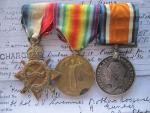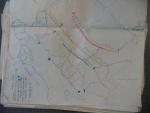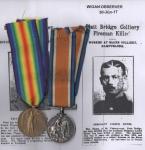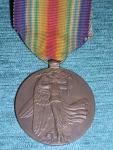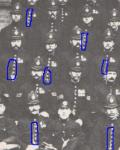-
Posts
3,687 -
Joined
-
Last visited
-
Days Won
2
Content Type
Profiles
Forums
Blogs
Gallery
Events
Store
Everything posted by Tony
-
My 2nd only S. African group and first from the Great War. I was attracted to this group as it’s named to a Boer and mounted in the wrong order although I’m unsure when the group was mounted. It doesn’t appear to have been worn much. It would have been more interesting for me to have a trio to a man who served in GSWA and also at Delville Wood but he didn’t so I’ll have to learn about the campaign in Africa especially the rebellion. Some paperwork came with the group, showing next of kin, address, illnesses of which he had many and also showing his medals weren’t issued until 1928. Is there any other paperwork, records etc. that can be easily accessed and was it normal for South Africans to have their medals issued 10 years after the war ended? One more question, were Botha’s Mounted Rifles a well known fighting force before being disbanded? Tony
-
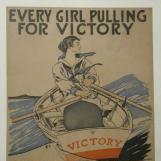
A very successful trench raid
Tony replied to Tony's topic in Great Britain: Research, Documentation & History
Thanks. You was going to check the Reichsarchiv Vol. 13 for me to see who was opposite. Remember? . My volumes from June 1917 onwards have gone missing. Tony -

A very successful trench raid
Tony replied to Tony's topic in Great Britain: Research, Documentation & History
This actual summery of events will give an idea of what happened during a raid, no doubt similar whether carried out by British, French or Germans. At 8.25pm artillery, T.M.'s and M.G.'s open to time, all guns accurate. 8.30pm First wave formed behind wire parallel to objective and moved off to time, screened by most effective smoke cloud to south. This cloud blotted out Dump and Madagascar Village though a few casualties were inflicted by machine guns from that direction. Sgt. Heyes was quite possibly killed by these MGs 8.31pm Guns lifted off German front line. 1st wave rushed over first objective and formed up close under barrage leaving behind moppers-up found by A and B Companies. These moppers-up accounted for 7 Germans found in the open in addition to 2 bayoneted by 1st wave passing over. 8.33pm Barrage crept onto green line on which it paused for 4 minutes. During this period a German machine gun team of about 7 came out with hands up from Madagascar Village on extreme right. This party was engaged by right blocking party who accounted for 3 of them. 2 others were hit but got away. Another party of 5 Germans jumped up from a shell hole and ran into our left flank barrage. They were fired at and 2 hit. 8.38pm Barrage lifted off green line, 1st wave again passed over leaving moppers-up. 4 Germans found in open and killed near northern flank. Another party of an officer and 5 men also emerged from a dug out about centre of green line without equipment. The officer and 3 men were killed, 2 escaped down a tunnel. Moppers up then blocked entrances to all tunnels till arrival of sappers with mobile charges. Barrage at same time crept onto red line, closely followed by first wave. This wave arrived at final objective exactly to time at 8.48. Between 8.38 and 8.48 the second and third waves dealt with several parties of Germans emerging from tunnel dug outs in 1st and 2nd objectives, collecting 14 prisoners in all, 9 of whom showed fight on the way back and were bayoneted. 5 prisoners only were brought in of whom 4 were wounded. 1 prisoner tried to throw a bomb into No. 2 sap on arrival in our lines and was consequently shot. 1st and 2nd objectives were both good fire trenches about 9 feet deep and full of tunnel dugouts. 13 of these were blown up with mobile charges by the sappers, who could easily have used far more than those they took over, one of which failed to explode. 1st and 2nd objectives are evidently connected by tunnels with several exits in both trenches. At the exit of one of these trenches a rifle rack containing about a dozen rifles was found. During the withdrawal at 9.03pm a party of 11 Germans emerged from this exit without equipment. They tried to show fight but most were killed, 3 or 4 escaping down the tunnel. At southern end of 2nd objective a new German light machine gun was found but was dropped and never recovered. Meanwhile1st wave had reached final objective. This trench is reported as a deep communication trench containing some dug outs which were bombed. 7 Germans were found and killed and two other parties of about 6 each ran away into our forward barrage. 4 were knocked over by rifle fire from one party and 2 from the other. A minenwerfer was found in this trench and temporarily disabled with bombs; no mobile charges available. The gun team of 8 Germans were all lying dead round the gun, evidently killed by artillery fire. On the return journey 15 dead Germans were counted between objectives, evidently caught in our barrage fire while trying to run away. Withdrawal The withdrawal commenced 7 minutes before time as all parties reported no more damage to do. Before withdrawing a thorough search was made of all dug outs. Lack of sufficient mobile charges handicapped work of destruction, but those for which no charges were available were dealt with by phosphorous and Mills bombs. Parties report many dug outs occupied. Talking heard from inside but damage unknown, though probably heavy. All parties report Germans showed very little fight. Direction Attacking waves found some difficulty in keeping direction chiefly because of dust kicked up by our bombardment and the tendency of troops to slip off towards smoke barrage on right. The trees at Les Briques on northern flank helped considerably to keep direction. Smoke cloud The value of the smoke cloud cannot be over estimated. It obscured the Dump at Madagascar Village preventing accurate German machine gun fire and in addition drew nearly all hostile retaliation. Machine gun fire from the north about Railway Craters was considered possible. In consequence a small party of 1 officer and 8 men including one sapper were detailed at zero + 7 to tackle the two suspected German M.G's. On arrival this party found trenches badly knocked about. Two dug outs were found both of which contained Germans, a mobile charge was blown in each. One man ran out just as charge exploded and was bayoneted. Action of Germans Germans kept on sending up golden rain and various coloured rockets which did not appear to serve any useful purpose and it wasn't until 9.45pm that any effective fire was brought to bear on the area of operations. Old Boots and Sussex trenches rather knocked about but no serious damage. After return to our lines box barrage taken off and guns concentrated on Les Briques line to give the impression that our attack would be pressed further. The action of the artillery was excellent throughout and worked exactly to programme. The excellence of the barrage will result in increased confidence of infantry in artillery in future operations. The party of R.E. Attached proved of the greatest service, carrying out their duties in a most servicable and systematic manner. Signalling At about 9.10pm the line back to Brigade H.Q. Was broken by shell fire but visual signalling was at once established and messages were received very quickly and satisfactorily from our station in fosse 9. Messages were also received by pigeons. Surprise According to statements made by prisoners, it appears that our attack came as a complete surprise to the enemy. If these reports are to be believed their tunnels contained after our attacks had passed over, at least 70 to 80 men, so if all these tunnels were P bombed and the entrances blown in by mobile charges, it is reasonable to suppose good results were obtained. Enemy casualties On a moderate estimate enemy casualties should have amounted to about 100 but these do not include casualties caused by mobile charges in dug outs which cannot be definitely included. Casualty Report Officers killed 0 Other ranks killed 5 Officers wounded 1 Other ranks wounded 45 mostly slight Officers missing 0 Officers missing, reeported wounded 0 Other ranks missing 4 Other ranks missing, reported wounded 1 Signed and dated 9.6.17 Five NCO's were recommended for immidiate rewards for displaying conspicious gallantry during the raid. Tony -

A very successful trench raid
Tony replied to Tony's topic in Great Britain: Research, Documentation & History
Below is a scan showing the equipment to be carried by each man. The moppers up have a larger selection of weapons for use against the enemy. 30 wire cutters were distributed amongst the attackers, attached to the men by a cord to prevent loss. I'm not sure if the reason for attaching them by cord was because they were expensive, issued by the CQMS in person, hard to come by or just easy to lose. The order was later changed to them being given to all men involved in the attack. -

A very successful trench raid
Tony replied to Tony's topic in Great Britain: Research, Documentation & History
Time table: Zero – 5 Intense barrage on enemy front line. Zero + 1 Barrage on front line creeps to green line arriving there at zero + 3 Zero + 2 Infantry due hostile front line Zero + 3 Frontal fire batteries lift to red line Zero + 5 Oblique and infilade batteries switch to yellow line Zero + 7 Oblique and infilade batteries switch to red line. Zero + 7 Infantry due green line Zero + 12 Frontal fire batteries ( less named guns) to Les Briques line. Zero + 16 Oblique batteries lift to Les Briques line. Frontal firing batteries to standing barrage on flanks. Zero + 17 Enfilade batteries switch to Les Briques line. Zero + 18 Infantry due red line (reserve trench) -

A very successful trench raid
Tony replied to Tony's topic in Great Britain: Research, Documentation & History
The raid took place in the evening of 8.6.17, the following extracts come from the 2/5 battalion diary. The Plan The operation referred to in the 199th Infantry Brigade Operation order No. 24 will take place on the evening of June 8th 1917 at an hour to be notified later to all concerned. The 2/5 Manchester Regiment will attack enemy trenches as under on a time table. Enemy front line – referred to as first objective or front line. Enemy support line – referred to as 2nd objective or green line Enemy reserve line – referred to as 3rd objective or red line Yellow line is for artillery purposes only. Timetable for the attack: Enemy front line to be occupied by support Coy. and moppers up at zero + 5 minutes, they will remain until all other lines have returned to our trenches. Green line to be reached at zero + 7 Red line to be reached at zero + 18 Six R.E. Sappers with a supply of mobile charges from the 432nd Field Coy. will be among the moppers up to deal with tunnels and deep dug outs. Telephone lines to be destroyed and instruments to be brought back. Return to our lines will be timed to commence at 0 + 40 minutes, the complete operation being timed at zero + 60 minutes. The 2/5 Manchesters will form up for attack by 0 – 40 minutes on day of attack as follows: The 2 companies that are going over will move up via Railway Alley into the front line with their mopping and blocking parties. The support Coy. will be in Munster Tunnel until 2 Coys. have gone over, they will then occupy front line. The remaining platoon will be in Back Street where it joins Railway Alley. Trenches to be kept clear for exclusive use of 2/5 Manchester Regt. on day of operation from 0 – 40 onwards. Railway Alley and Boyeau 2 up trench only. Boyeau 6 and Dundee Walk down trench only. Regimental Police will be posted to keep these trenches clear and regulate traffic. Prisoners: Only a few prisoners are required and they should be sent back at once under a special escort to Brigade HQ. Identifications or portions should be brought back of all German dead found in trenches. On completion the 2/5 Companies engaged will return straight back to Noyelles. Watches to be synchronised at Brigade HQ at 12 noon and again at 5pm on 8th instant. An officer from all units taking part should attend with a watch. -

A very successful trench raid
Tony replied to Tony's topic in Great Britain: Research, Documentation & History
Trench map corrected to November 1917, quite a few months after Sgt. Heyes' death. However, there had been no change that I can see to the lines occupied by the British and Germans. -

A very successful trench raid
Tony replied to Tony's topic in Great Britain: Research, Documentation & History
The sketch below shows the lines occupied by the 2/5 and German front line, the green and red lines show the 2 main objectives to be taken in the German lines. -
Here's a pair of medals I bought a while ago, they are named to Sgt. Joseph Heyes of the 2/5 Manchester Regiment who was killed during the unit's first ever trench raid. The 2/5 suffered only 9 casualties during the raid. Casualties were taken by machine gun fire when leaving the trench. Joseph Heyes was quite possibly one of the men killed in the first minute of the raid by German machine guns firing aimlessly through the smoke cloud laid down by No.4 special Company R.E. from areas off to the right known as The Dump and Madagascar Alley. The reason for suggesting he was killed at the start is because his body was recovered and buried just a few hundred metres behind the line. Privates William Toulmin, Herbert Whitaker and William Jones are also buried in Cambin whereas the other 5 casualties of that evening – Pte. Charles Dodd, Henry Elliot, Charles Gleave, Charles Stanley Griffiths and Sgt. James Lomax are remembered on the Loos Memorial. The photocopy newpaper clip from the Wigan Observer is dated 30th June 1917 and tells that Joseph from Platt Bridge, Wigan was a Colliery Fireman who worked at the Mains Colliery Bamfurlong, he was 33 at the time of his death and had been in France only three months.
-
Hello Phillipe, Do you mean aerial photos? If so, I know that the numbers on RFC/RAF photos refer to the exact spot (or near enough) on the corresponding trench map. Is it possible that German maps have a similar reference? If this is the case then photographed areas could possibly be found online and I stress possibly. Hope you get a definite answer as I'd find that interesting to know too. Tony
-

British Victory Medals
Tony replied to Kev in Deva's topic in Inter-Allied Victory Medals of the Great War
Here are a couple I have with different style naming although I don't know which type. One has round stops, the other has square stops. These are things I never really noticed before. Tony -

Here comes the .... Boom!
Tony replied to Chris Boonzaier's topic in Great Britain: Militaria: Badges, Uniforms & Equipment
A Stokes? They used to be all over the place in N. France/Belgium back in the late 80s however, I've never seen one in that good a condition. Tony -

Victory Medal Ribbons in General
Tony replied to Tim B's topic in Inter-Allied Victory Medals of the Great War
Thanks for the quick reply Tim. I'll look forward to hearing what Rob has to say when he has the time to go online. Tony -

Victory Medal Ribbons in General
Tony replied to Tim B's topic in Inter-Allied Victory Medals of the Great War
And British. I should add that this soldier's group came together with his brother's group. The brother's group is as issued with full length ribbons and never worn, whereas the VM shown may have been displayed by the family or a collector and therefore faded. Or it's not a British issue ribbon, what do you think? Tony -

Victory Medal Ribbons in General
Tony replied to Tim B's topic in Inter-Allied Victory Medals of the Great War
-

Victory Medal Ribbons in General
Tony replied to Tim B's topic in Inter-Allied Victory Medals of the Great War
I have 3 ribbons to show, the first is on a Czech VM, the second is on a French VM and the third on a British VM. Are the French and British ribbons both British issues and does the British one only look that way because it's faded or should it be on the VM from a different country? Tony -

British Victory Medals
Tony replied to Kev in Deva's topic in Inter-Allied Victory Medals of the Great War
Thanks for the info Gunner. I think I only have 2 VMs to officers but will be checking all I have in case a type I to an OR is there somewhere. Tony -

A few WWII Campaign Medal Claps - Original?
Tony replied to Kano's topic in Great Britain: Orders, Gallantry, Campaign Medals
Hello Kano, Welcome to the forum. I don't really know much about WWII militaria and usually go by the holes in the clasp for sewing to the ribbon. If they're tiny, neatly packed away in each corner and don't have any burr on the reverse then chances are you have a good copy or an original but, as my answer isn't really much help you should have a look at this page http://www.lancs.ac.uk/staff/hartleyi/bobclasp.htm Although it's mainly about the rare Battle of Britain clasp there are others shown too, one of them being the Pacific clasp. Tony -

british silver medals in danger?!
Tony replied to paddywhack's topic in Great Britain: Orders, Gallantry, Campaign Medals
Some records. Most service records to other ranks were destroyed by the Luftwaffe. Tony -
I only have one SA group, the standard 4 medals so no variations unfortunately. It's similar to Fann's group but no Efficiency medal or bar to the Africa Star. Do either of you know the criteria for the bar being awarded? His service papers are somewhere only I've forgotten where I put them. Thanks for any help. Tony
-

Camberwell police
Tony replied to Tony's topic in Great Britain: Mervyn Mitton's British & Colonial Police Forces
I think I'll keep an eye out for more police photos, the information from everyone has been very interesting indeed. Tony -

Camberwell police
Tony replied to Tony's topic in Great Britain: Mervyn Mitton's British & Colonial Police Forces
Mervyn, I've cropped the photo and ringed (in an amateurist way) what look like whistle chains to me. Tony


